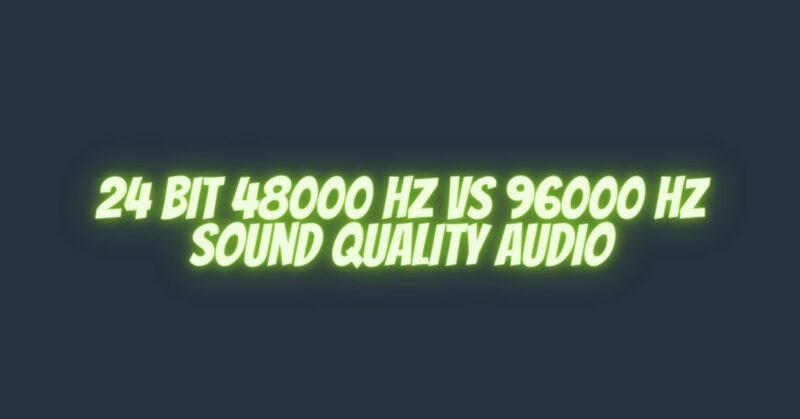In the world of audio production, sound quality reigns supreme. Two crucial factors that heavily influence the sonic fidelity of your recordings are bit depth and sample rate. In this article, we’ll take an in-depth look at the differences between two common audio configurations: 24-bit, 48,000 Hz, and 24-bit, 96,000 Hz. By understanding the nuances between these settings, you can make informed decisions about your audio recording and production needs.
Bit Depth and Sample Rate: A Brief Overview
Before we dive into the comparison, let’s recap the fundamentals of bit depth and sample rate:
- Bit Depth: Bit depth refers to the number of bits used to represent the amplitude of each audio sample. Higher bit depths offer more precision and accuracy in capturing audio amplitude, resulting in a wider dynamic range.
- Sample Rate: Sample rate, measured in Hertz (Hz), denotes the number of audio samples recorded per second. It defines the frequency range that can be accurately captured in an audio recording.
24-bit, 48,000 Hz Audio
- Bit Depth: In a 24-bit configuration, each audio sample is represented using 24 bits. This affords an impressive level of precision and a substantial dynamic range, resulting in minimal quantization noise and exceptional audio fidelity.
- Sample Rate: A sample rate of 48,000 Hz is commonly used across various audio production applications, from music recording and podcasting to film and multimedia production. It accurately captures frequencies up to 24,000 Hz, spanning the entirety of the human audible spectrum.
24-bit, 96,000 Hz Audio
- Bit Depth: The 24-bit bit depth remains consistent in a 24-bit, 96,000 Hz configuration. This ensures that the dynamic range and precision remain top-notch, as in the 24-bit, 48,000 Hz setting.
- Sample Rate: Doubling the sample rate to 96,000 Hz allows for even greater frequency accuracy. It captures frequencies up to 48,000 Hz, extending beyond the upper limit of human hearing. This expanded range offers unparalleled precision for high-frequency audio content.
Comparing the Two
Now, let’s closely examine the distinctions between these two audio configurations:
- Audio Fidelity:
- 24-bit, 48,000 Hz: This configuration delivers exceptional audio fidelity, making it suitable for a wide spectrum of professional audio recording and production applications. Its high bit depth guarantees minimal quantization noise and an expansive dynamic range.
- 24-bit, 96,000 Hz: With the increased sample rate, this configuration excels in capturing and reproducing high-frequency content with extraordinary precision. It retains the same high bit depth, ensuring minimal quantization noise even in the most demanding audio recordings.
- Use Cases:
- 24-bit, 48,000 Hz: This configuration is the industry standard for numerous audio production tasks, including music recording, podcasting, video production, and multimedia content creation. It offers an excellent balance of audio quality and practicality.
- 24-bit, 96,000 Hz: The 24-bit/96,000 Hz configuration is often preferred for tasks that demand the utmost precision and fidelity, especially in professional music studios, audiophile recordings, and situations where audio undergoes extensive processing or pitch-shifting.
- File Sizes:
- 24-bit, 48,000 Hz: Audio files recorded at this sample rate and bit depth are more manageable in terms of storage and data transfer. They strike an ideal balance between audio quality and practicality.
- 24-bit, 96,000 Hz: The higher sample rate results in larger file sizes. Users should be prepared for the increased storage and processing demands associated with these files.
In the head-to-head comparison between 24-bit, 48,000 Hz, and 24-bit, 96,000 Hz audio configurations, both offer exceptional audio quality. The choice between them hinges on the specific audio production needs you’re aiming to fulfill. For most applications, 24-bit, 48,000 Hz provides outstanding fidelity and is the go-to choice across the audio industry. However, if you require the highest precision and intend to work extensively with high-frequency content, 24-bit, 96,000 Hz emerges as the superior option. Ultimately, your decision should align with your production objectives, available resources, and the nature of the audio content you’re dealing with.

